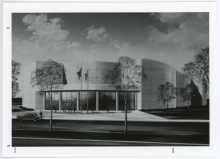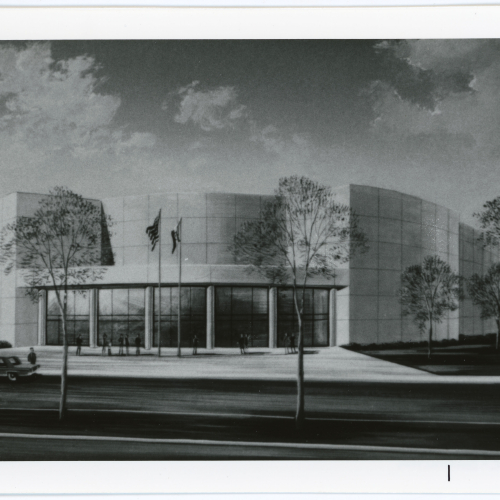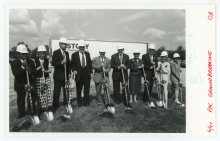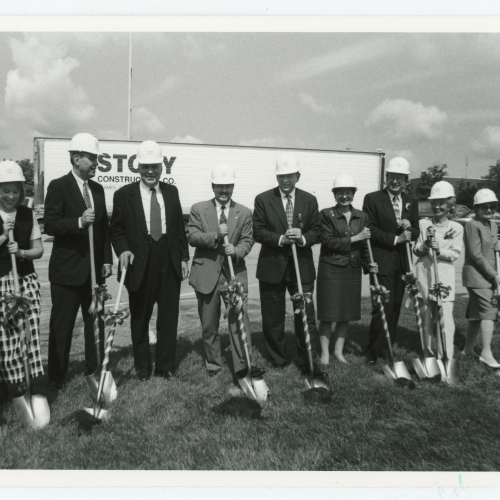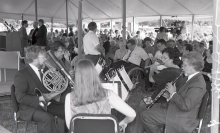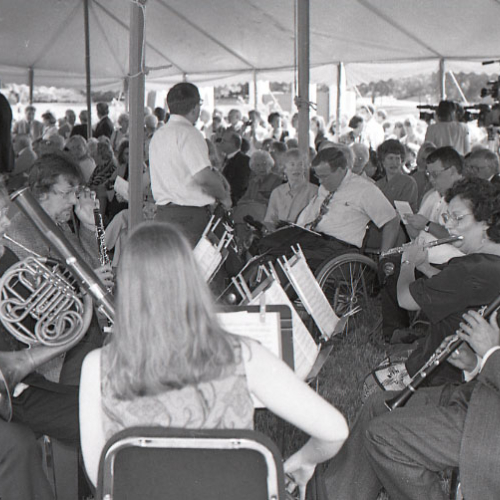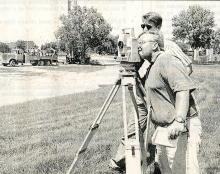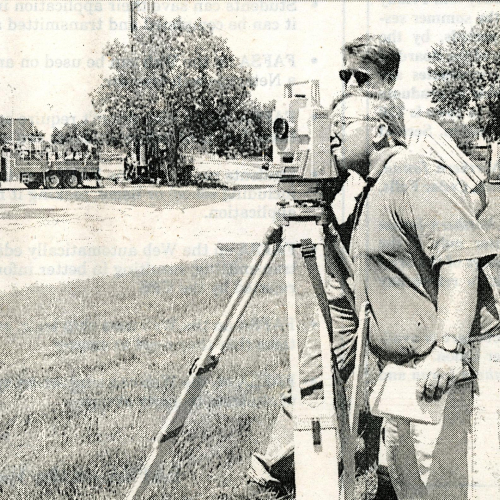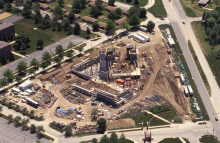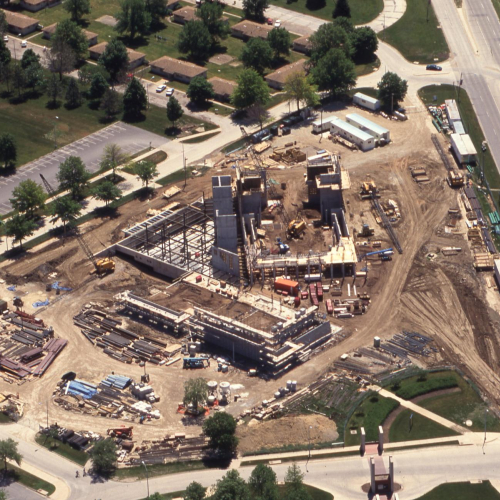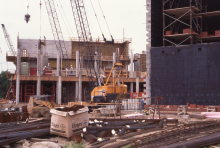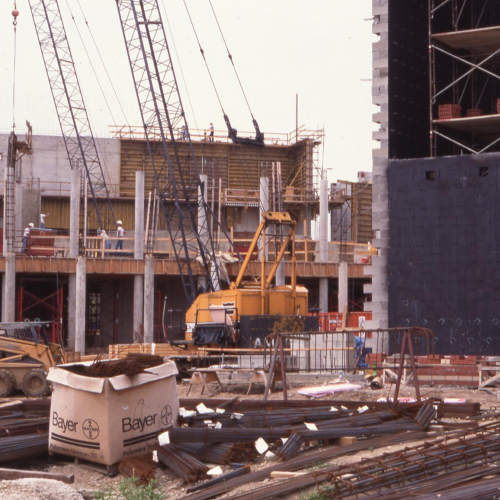Gallagher-Bluedorn Performing Arts Center (1997)
The search for an adequate fine arts auditorium at UNI dates back to the end of World War II. In December 1944, with a successful resolution to the war in sight, the Legislative Interim Committee of the Iowa General Assembly proposed spending $900,000 on building construction at the Iowa State Teachers College, now the University of Northern Iowa. Along with proposals for a health services building, a laboratory school, and an arts and industries building, the plans included a new auditorium. The auditorium located in what was then called the Auditorium Building (now Lang Hall) was considered inadequate in both capacity and function. The proposed new building would include a large auditorium, two smaller auditoriums, and classrooms.
However, postwar inflation and a need for other facilities stalled plans for the new auditorium. Latham Hall, an arts and industries building was completed in 1949; Price Laboratory School was completed in 1957; and the Student Health Center was completed in 1961. Performances like the Lecture-Concert Series, later known as the Artists Series continued using the Auditorium Building, with its small stage and less than adequate seating, acoustics, and parking. College dramatic productions and other campus shows also remained in Lang Hall.

Calls for a new auditorium grew louder in the late 1960s. In a 1967 letter to the College Eye, Professor Robert Claus cited the upcoming American Bicentennial and UNI Centennial in 1976. He asked, "How about a Century Fund to help build an auditorium for the performing arts?" The College Eye editorial board picked up the same sentiments later that month. The board noted that the auditorium had been inadequate to handle crowds interested in hearing two recent speakers, including American Nazi George Lincoln Rockwell. It also noted that the 1967-1969 Regents capital improvement plans included a physical education building, but not an auditorium. In a mild demonstration of protest, posters appeared on campus bulletin boards urging all students to attend the Matriculation Convocation and to demand a seat. By doing this, students hoped to impress upon school administrators the need for better facilities. In February 1968, an Ad Hoc Committee on Auditoria Needs presented recommendations that included a coliseum seating 10,000, an auditorium seating 2,000, and a theater seating 800. Professor Stan Wood chaired that committee.
Members included Harold Bernhard (religious activities), Jean Bontz (women's physical education), James Coffin (music), Howard Jones (Artists Series), John Ketter (student union), Myron Russell (music), Edward Thorne (speech), James Witham (men's physical education), and Robert Porter (architect). In April 1968, Sue Mulder, Class of 1968, announced that her class would attempt to raise $3,000 as a gift toward building a new auditorium. In February 1969, the Class of 1969 set a goal of $5,000 as its gift for the same purpose. By April, they had raised $6,684.
The recommendations drawn up by the Ad Hoc Committee in February 1968 were presented to the faculty in October 1969 in a more concrete form. The cost of the three facilities would be $9 million: $4 million for the coliseum, $3 million for the auditorium, and $2 million for the theater. The UNI Foundation would contribute $5 million to the overall cost. The other $4 million would come from contributions rather than appropriated state funds. The committee hoped that construction on at least one of the facilities would begin in 1976, the UNI centennial year. The coliseum would be used for athletics, mass meetings, conventions, commencements, and speakers. The auditorium would feature a large stage for professional touring attractions, separate rehearsal space, workshops for scenery and costume construction, professional motion picture projection facilities, large screen projection, and TV outlet circuits." The theater would include a main stage and two studio stages, rehearsal rooms, workshops, dressing rooms, and a public lobby.
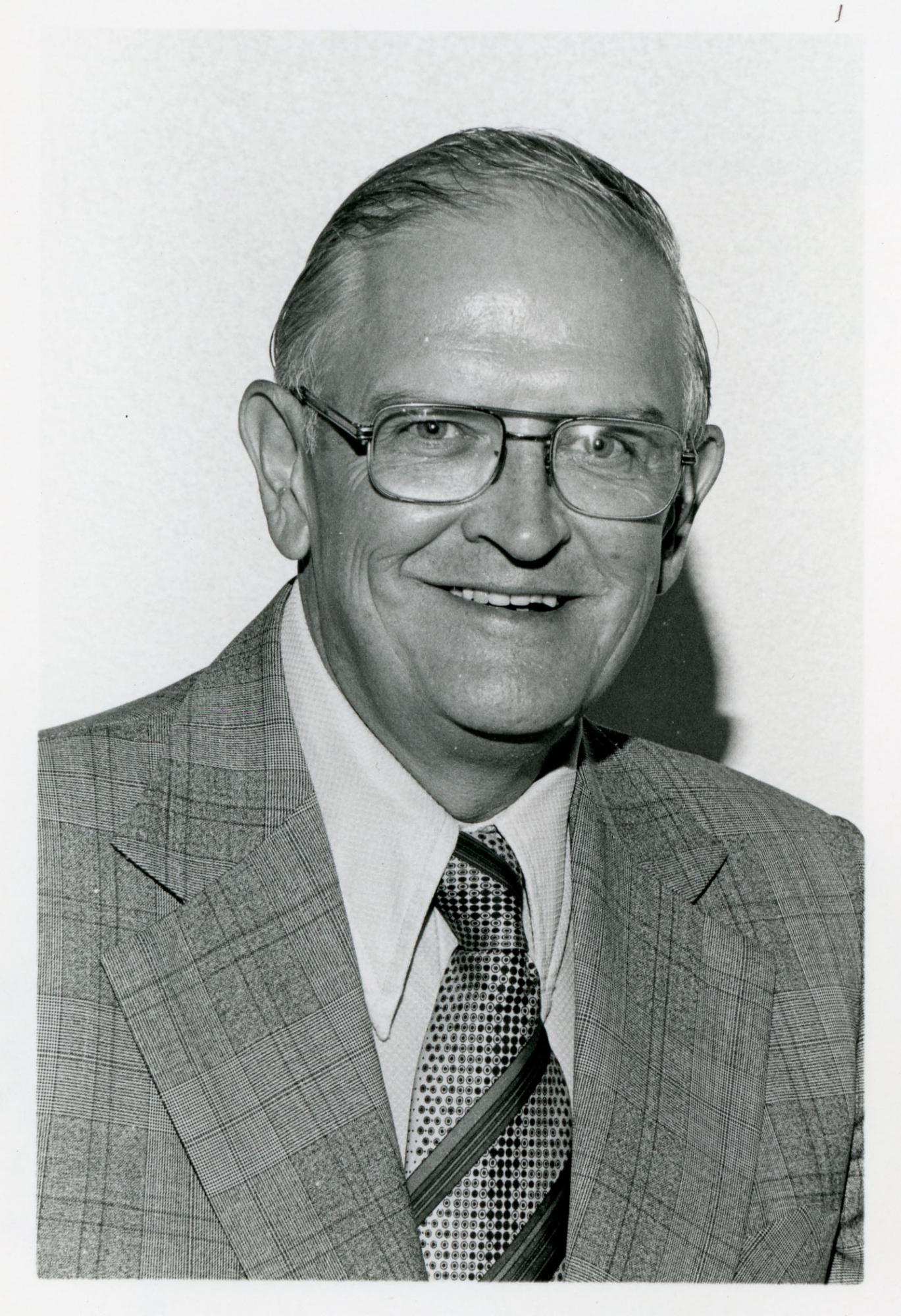
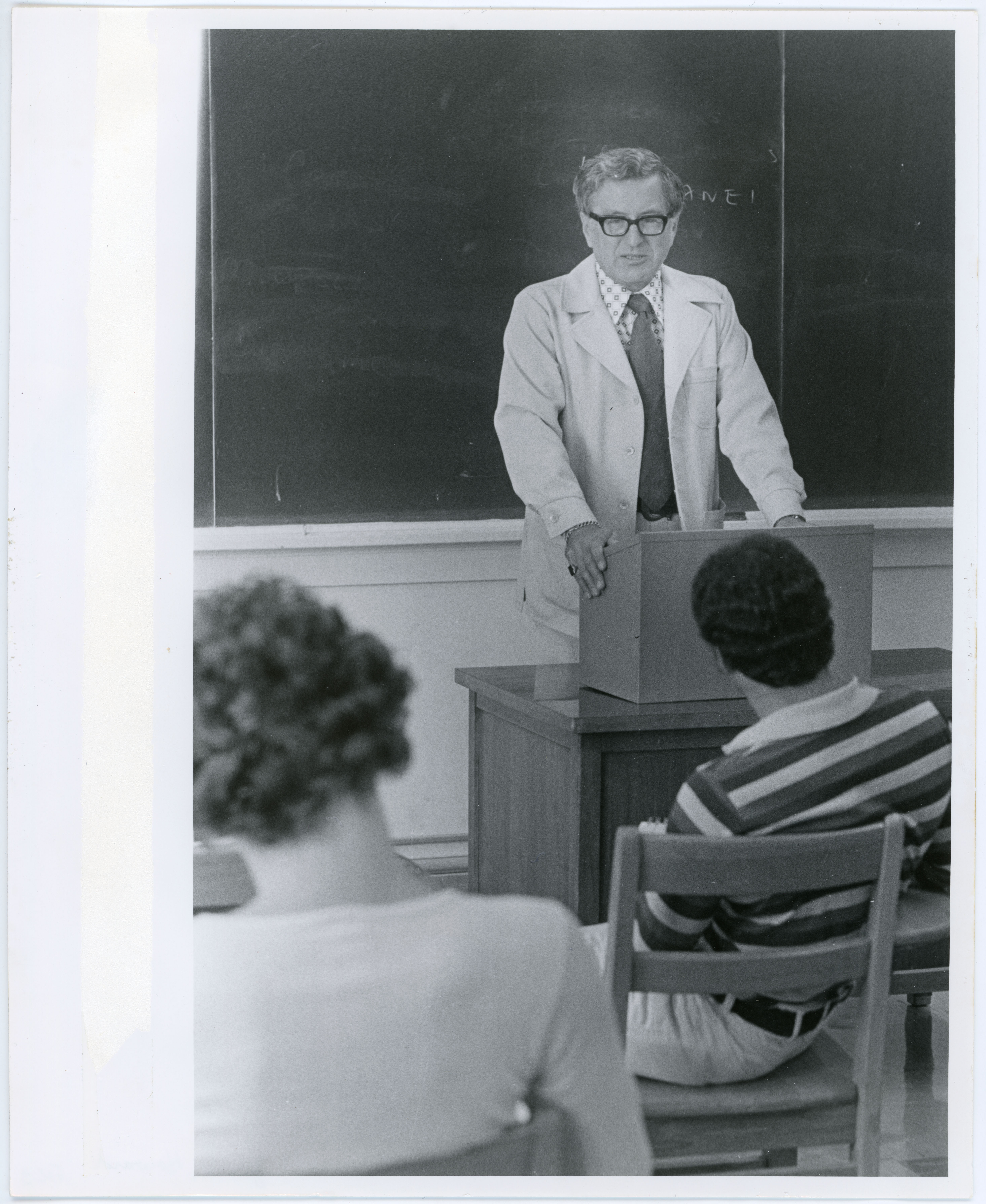
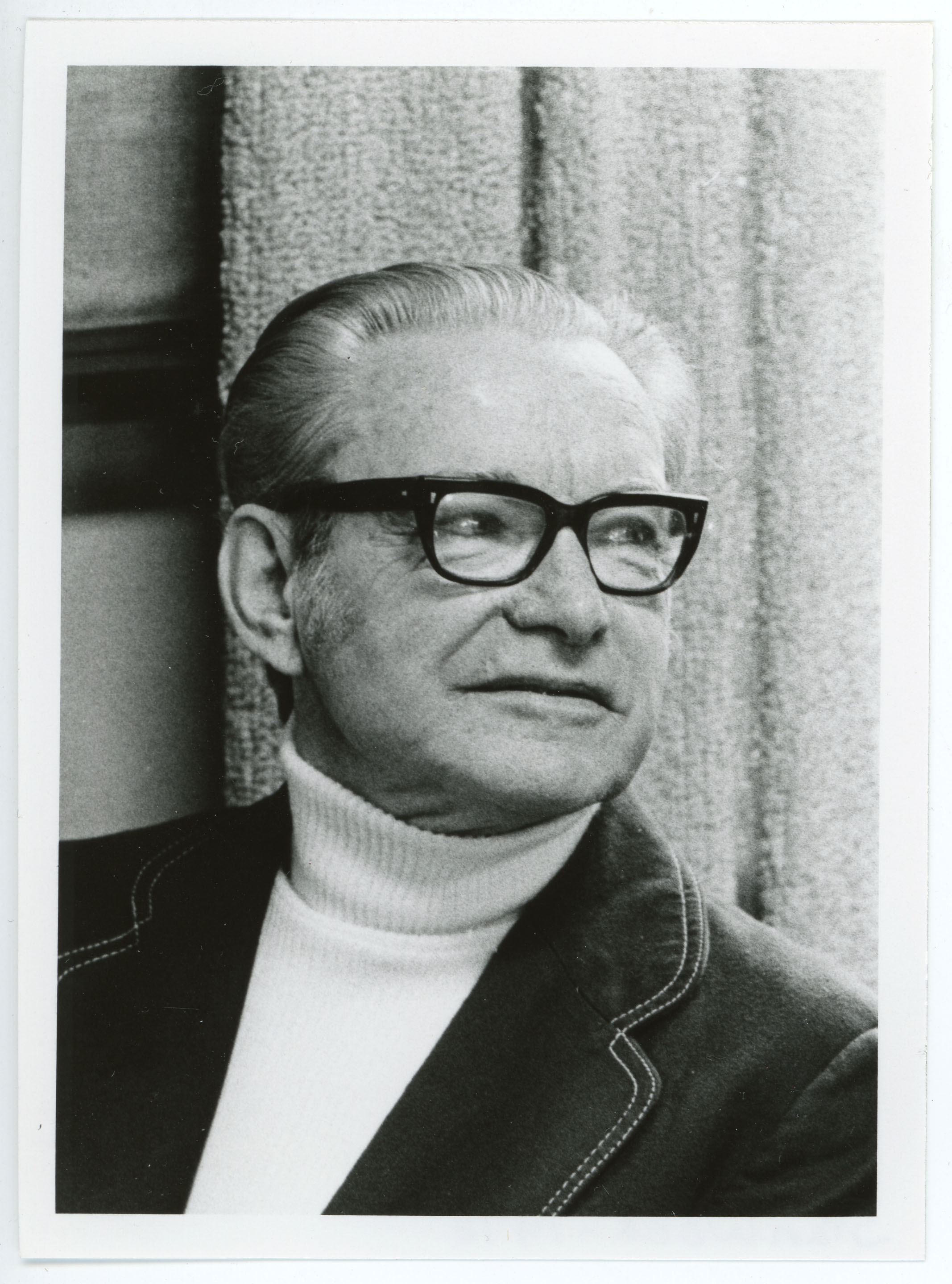
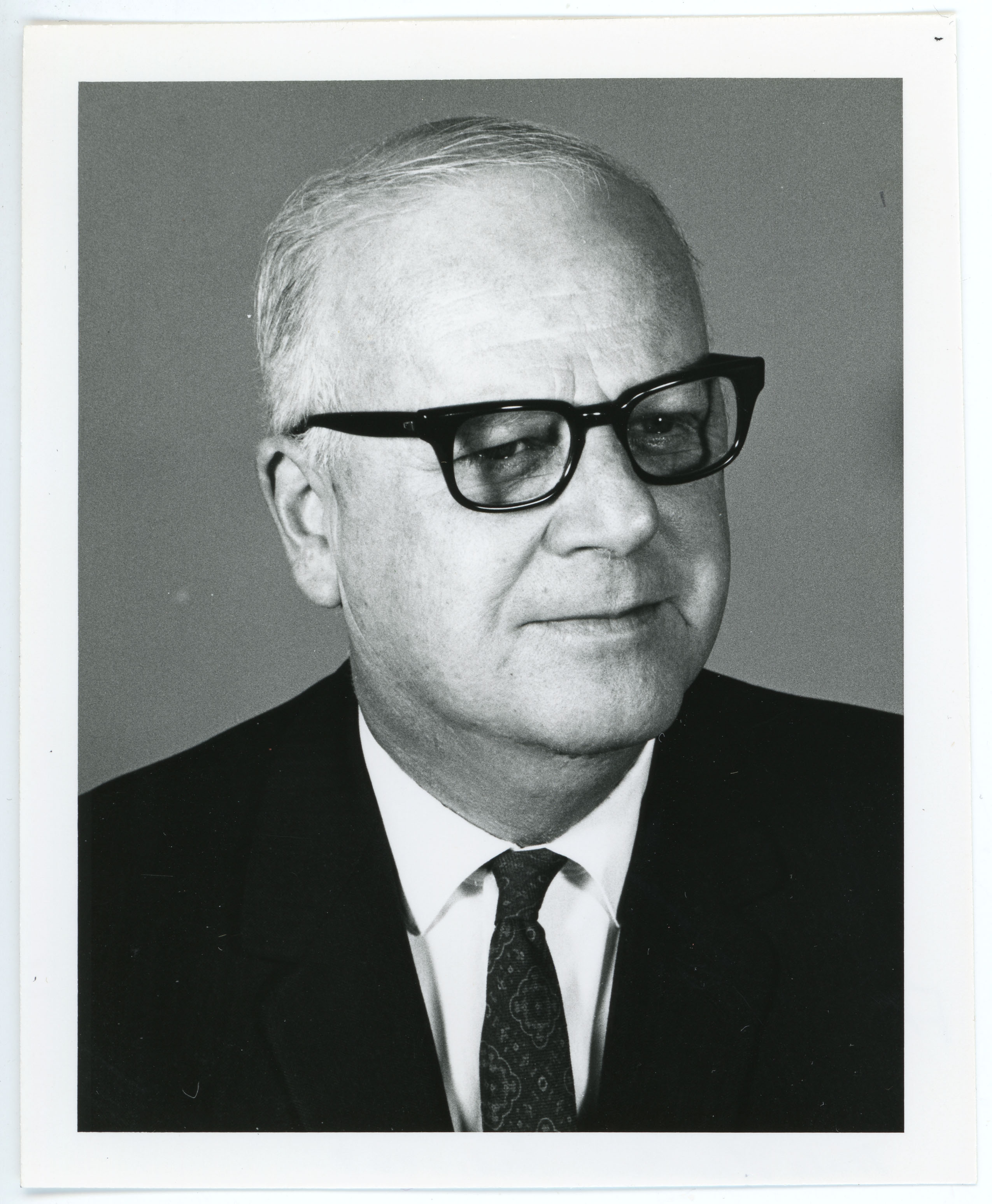
In the spring of 1970, the UNI Foundation retained Cumerford Company of Kansas City, Missouri, to conduct a fund-raising feasibility study before undertaking the auditorium complex as an official Foundation project. Despite discouraging reports from their fund-raising consultant, in December 1972, the UNI Foundation launched a $10 million fund drive, known as the Centennial Capital Campaign. This would be the university's first major fund drive and would be organized into two phases. Phase I would be a coliseum for athletic events, while Phase II would be an auditorium for the performing arts. The two phases would cost a total of about $8.5 million. The remainder of the $10 million raised might be devoted to other needs, including a museum, an observatory, special equipment, or endowed faculty chairs. Foundation President Harry Slife stated that Phase I (the coliseum) would have priority over Phase II because fund-raising for athletics facilities had a stronger potential for success than did fundraising for fine arts facilities. Private donations would still provide a large part of the funding, but officials noted that student fees would also be used. T. Wayne Davis, president of Latta's (now University Book and Supply) and a UNI alumnus, was named National Centennial Fund Drive Chairman.
With the perception that athletics had priority over fine arts, and with student fees entering the picture, the battle lines were drawn. A significant number of faculty and students did not like this priority or the allocation of student funds to the project and felt decisions had been made without appropriate consultation. Some believed donations meant for a fine arts facility would be used for athletics instead. Despite the sometimes acrimonious debate, the UNI-Dome was completed in 1975 at a cost of $7.5 million, financed by private donations and student fees and Strayer-Wood Theatre was completed in 1978, with state-appropriated funds. In the meantime, the proposed Phase II of the Centennial Capital Campaign, the fine arts facility, seemed to languish. The long delay in its construction engendered a bitterness among some members of the UNI community that persisted for many years.
In the early 1980s, there were fleeting references in UNI publications to the need for a new auditorium. In a letter to the Northern Iowan, student Jim Maltby wondered if UNI was large enough to support such a facility. Could UNI support something like Iowa State University's C. Y. Stephens Auditorium or the University of Iowa's Hancher Auditorium? In 1983, Director of Alumni Services and Development Lee Miller noted that the Board of Directors of the Waterloo/Cedar Falls Symphony Orchestra had recommended building an auditorium with a seating capacity of 2,200-2,500 for $8-16 million. Miller also noted that the location of the facility and the source of funding were still cloudy. UNI alumnus Richard Frevert, coordinator of operations for the Waterloo/Cedar Falls Symphony Orchestra in 1984, worked with Howard Jones and others to make the plans more concrete. In 1986, a Blue Ribbon Committee from the arts, business, and UNI concluded that such a faculty should be built on the UNI campus.
In July 1988, President Curris named a ten-member performing arts center planning committee. The committee chair was Leland Thomson, Director of UNI Facilities Planning. The committee, composed of members of the greater community, wanted to reflect both UNI and community interests. David Buck, Rachel Fulton, and William Hinson were from Waterloo; Junean Witham and Edward Voldseth were from Cedar Falls; and Peter Hamlin, Howard Jones, Ronald Ross, and Dee Vandeventer represented UNI. In naming the committee, President Curris said, "There is a growing awareness that the establishment of a performing arts center can be achieved only through a cooperative effort between the University and the Waterloo and Cedar Falls communities." By February 1989, the committee had arrived at three potential building sites:
- near the intersection of West 18th Street and Hudson Road;
- west of the UNI-Dome or south of the intersection of West 27th Street and Hudson Road;
- west of the Industrial Technology Center.
The facility would be planned to accommodate the Waterloo/Cedar Falls Symphony Orchestra, the Chamber Orchestra of Iowa, the Metropolitan Chorale, and UNI's Symphony Orchestra, Wind Symphony, choruses, Lyric Theatre, and Suzuki Strings.
Certainly the local community would benefit from a new facility, but students and faculty of the UNI School of Music were also looking forward to it. Some music students and faculty found significant acoustical problems with the Russell Hall auditorium. Others cited lack of space in Russell Hall for an expanded enrollment in music classes.
In January 1992, alumnus Richard Devin, who assisted in planning for the Strayer-Wood Theatre, came to campus to begin planning and design discussions among the potential users of the proposed performing arts center. At that time, the cost for the facility was estimated to be $14 million, with $9 million to come from private donations.
In 1990, the UNI Foundation commissioned a feasibility study on fundraising for the faculty. In April 1992, the R. J. McElroy Trust of Waterloo pledged $500,000 toward the proposed center. Alumni and students also supported the fundraising efforts. By the summer of 1992, a sketch of the facility had emerged.
At that same time, the UNI Foundation pledged $3.8 million of its "Leading, Building, Sharing" capital campaign to the facility. Professor Ronald Ross, just completing seventeen years as Director of the School of Music, was named Special Assistant to the President for the building project. Dennis and Camille Hogan, both alumni and local citizens, chaired the major gifts effort. Late in 1992, Carl and Peggy Bluedorn pledged $300,000 to the project. Early in 1993, the UNI-Civic Arts Association donated $100,000 from funds accumulated over its twenty-year history. Viking Pump, Incorporated, donated $25,000. Standard Golf Company gave $75,000. Alumna Noma Rupprich Jebe donated $300,000.
By mid-1994, donations had reached $6.5 million of the $9 million Foundation goal. Vice President for Development Joe Mitchell said that the "time is right to begin work toward planning and construction." On the public side of the fundraising effort, the Board of Regents made the project the top priority on its capital budget request for funding by the General Assembly and support by Governor Branstad in the 1995 legislative session. The Regents recommended that a total of $8.8 million in state funds be made available to UNI for the project. Governor Branstad responded with support for $2 million of the requested funding. By February, the Foundation had reached the $8.5 million mark in pledges. In March, after serious lobbying by UNI students, a General Assembly House committee recommended support for the $2 million state appropriation. This recommendation passed and was signed into law.
By early 1995, UNI was looking for an architect for the project. Forty-five companies or groups made proposals. Ultimately, UNI selected Hammel Green and Abrahamson of Minneapolis, in association with Flinn Saito Anderson of Waterloo, as the project architect. The Regents approved the contract on April 17, 1995. Hammel Green and Abrahamson had previously designed projects at the University of Minnesota, Valparaiso University, and Luther College. In September 1995, the Facilities Planning Advisory Committee recommended a site for the new building. The Committee proposed that it be located on the southern portion of the large parking lot just north of University Avenue.
Director of Facilities Planning Morris Mikkelsen said that the proposed site met the following criteria:
- site access for both students and the general public;
- parking availability;
- utility connections and site work requirements;
- and proximity to Russell Hall.
Although there was some protest about the loss of parking space, President Koob and the Cabinet approved the recommendation. Officials hoped to begin construction by the fall of 1996.
The Regents made the remainder of the requested state funds, $7.1 million, the top priority for new construction for fiscal year 1997. In February 1996, the Regents approved the schematic design, and in April they approved the exterior design. The building would include 99,000 gross square feet, with an auditorium seating 1,600. Seating would be split into four different areas: orchestra seating for 470, parterre seating for 300, mezzanine seating for 400, and balcony seating for 430. The seats would be staggered and the floor angled slightly for better viewing. Some of the seats would be removable to provide access for the handicapped. The budget would be about $19 million, with $10 million from private funds. In May, Governor Branstad signed a bill authorizing funding for the remaining state appropriations.
The groundbreaking ceremony for the new building was held June 25, 1997. Governor Terry Branstad was on hand to help turn the first shovel of dirt, along with other honored guests, such as UNI President Robert Koob, Lt. Governor Joy Corning, and contributors Edward and Cathy Gallagher.
The center was named in honor of two prominent Waterloo couples who each contributed at least $1 million to the project. Cathy and Edward J. Gallagher, Jr., and Carl and Peggy Bluedorn were all active in the community. Edward Gallagher was the senior partner in the Gallagher, Langlas & Gallagher law firm and served on many local boards. His wife, Cathy, is a 1977 UNI alumna and was also active on several boards.
Carl Bluedorn was president and chairman of the board of Zeidlers, Incorporated, and participated in many civic activities. Peggy Bluedorn was active in the American Red Cross for many years. President Koob remarked that the beginning of the project had been a long time in coming for both UNI and the Waterloo-Cedar Falls community. Members of the Waterloo/Cedar Falls Symphony Orchestra performed at the groundbreaking. Story Construction Company of Ames, the general contractor, began work in July 1997.
By late August, excavation and foundation work was well underway. Morris Mikkelsen said that the contractor hoped to complete footings, foundation, and piles so that masonry work could continue through the winter. Mild weather during the winter of 1997-1998 helped keep the project on schedule. Work continued on schedule during the summer of 1998, with a projected completion date early in 2000.
By early 1999, Center Director Bruce Marquis was already promoting the center's inaugural 2000-2001 season of entertainment. He said that he wished "to stress that the arts can and should be enlightening, inspiring, and educational, but that they can also be a celebration." The Class of 1999 voted to devote its class gift to landscaping the new Center. By November 1999, the Center staff was planning a grand opening for a week in mid-April; they even hoped to be able to move into portions of the Center in February to set up computer systems and to train other Center staff members. They hoped to offer over 150 performances annually.
The opening celebration, scheduled from April 6-19, 2000, included primarily local artists, such as the UNI Symphony Orchestra, a Lyric Theatre performance, the Wind Symphony, the Jazz Band, the Varsity Men's Glee Club, and the Waterloo/Cedar Falls Symphony Orchestra. The Artists Series for the inaugural season of 2000-2001 at GBPAC included Gregory Hines, Regina Carter, the Paul Taylor Dance Company, the Canadian Brass, the Royal Winnipeg Ballet, Stomp!, and the Afro-Cuban All-Stars. Audiences liked the new facility and the entertainment.
In July 2000, the Center received an award from Lieutenant Governor Sally Pedersen for its efforts to make the facility accessible to people with disabilities. She cited staff work in following both the spirit and letter of the law of the Americans with Disabilities Act. General contractor Story Construction Company won two awards from the Associated Builders and Contractors of Iowa for their work on the Center: first, the 2000 Project of the Year award, and, second, the 2000 Award of Excellence in General Construction.
Center staff kept in touch with their potential audience by utilizing both community and student advisory boards. To encourage attendance, student ticket prices were subsidized in the first season by a $70,000 grant from President Koob's office. In the fall of 2002, student Panther Passes included access to, or reduced prices for, certain Center events.
By April 2002, staff members reported that the Center had held 350 events during the previous academic year. Cash ticket sales had increased forty percent over the previous year and corporate donations had doubled. Forty percent of audiences were UNI students, forty percent were from Cedar Falls, and twenty percent came from elsewhere. About one-third of the Center’s budget came from UNI; the other two-thirds came from donations and fundraising. Center Director Steve Carignan stated that the Center seemed to have several audiences that attended particular kinds of performances, rather than one core audience that attended just about everything. He said that an economic impact survey found the Artists Series alone generated about $2.5 million in local spending.
In November 2009, at a concert by Itzhak Perlman, the university announced a major gift to the Center. Edward and Cathy Gallagher donated an additional $500,000 to establish the Edward and Catherine Cassidy Gallagher Endowment for the Gallagher-Bluedorn Performing Arts Center. The fund would support programming, equipment, and other projects. In an article in the Waterloo Courier, Mr. Gallagher said:
"We're excited about the Kaleidoscope program that gets kids interested in music and culture . . . And we're pleased to see that the Gallagher-Bluedorn has nurtured a growing interest in culture across the state. It has created a cultural niche for the Cedar Valley by hosting outstanding shows and Broadway performances. It has also been a deciding factor in attracting new businesses to the area. We couldn't be happier to celebrate 10 years of success."
Originally compiled by Library Assistant Susan A. Basye; edited by University Archivist Gerald L. Peterson, January 1997; revised July 1998; substantially revised by Gerald L. Peterson, with research assistance from Student Assistants Janelle Iseminger, Ashley Kluver, and Anthony Boggs and scanning by Library Assistant Gail Briddle, September 2003; last updated July 27, 2010 (GP); photos and citations updated by Graduate Assistant Eliza Mussmann, September 8, 2022; content updated by Graduate Intern Marcea Seible, June 2025.

